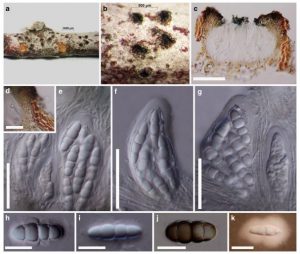Asterodiscus tamaricis Voglmayr, Gardiennet & Jaklitsch, Fungal Diversity: 10.1007/s13225–016-0356-y, [6] (2016). Index Fungorum number: IF815330
Saprobic on Tamarix species. Sexual morph: Ascomata 140–220 μm high × 170–310 μm diam. (x = 170 × 262 μm, n = 10), apothecioid, solitary or scattered, immersed, slightly erumpent through the bark, forming under black, irregularly shaped, shallow depressions on the host surface, pyriform to subglobose, with a wide irregular opening, ostiolate, ostiolar area black. Peridium 10–25 μm wide, broad at the apex, comprising several layers of lightly pigmented to brown cells of textura angularis, somewhat flattened at the base, broad and black at the apex. Hamathecium comprising 2–3 μm wide, numerous, septate, cellular pseudoparaphyses, with swollen free apical ends. Asci 75–105 × 30–48 μm (x = 90 × 40 μm, n = 15), 8-spored, bitunicate, broadly clavate, broadly fusoid to saccate, short pedicellate, apically rounded, with an ocular chamber. Ascospores 35–46 × 10.8–17 μm (x = 39 × 13.8 μm, n = 30), bi- to tri-seriate, hyaline, becoming brown to dark brown when mature, ellipsoidal, 3-septate, third cell from the base larger, constricted at the septa, deeply constricted at the central septum, smooth-walled, with a large mucilaginous sheath, which is constricted near the central septum. Asexual morph: see Voglmayr et al. (2016).
Culture characteristics: Ascospores germinating on PDA within 36 h and germ tubes produced from one or both ends. Colonies growing on PDA slowly, 25 mm diam. After 14 days at 25 °C, circular to slightly irregular, flat, surface white, becoming pale brown, when aged, smooth surface, with entire to slightly undulate edge.
Notes: Asterodiscus was introduced by Voglmayr et al. (2016) as a monotypic genus to accommodate A. tamaricis. Asterodiscus tamaricis is another Tamarix inhabitant species reported in Austria and Croatia. We collected A. tamaricis from Italy associated with Tamarix gallica. Massarina mauritiana Poonyth, K.D. Hyde, Aptroot & Peerally could be another species in Asterodiscus and is saprobic on Bruguiera gymnorrhiza (L.) Lam. (Rhizophoraceae). Asterodiscus closely resembles Massarina mauritiana in morphology, but can be distinguished by its smaller ascospores (26–34 × 8–9.5 μm), with a gelatinous sheath, which swells strongly in water and appears granular at the poles and refractive adjacent to the septa in M. mauritiana (Poonyth et al.1999). However, M. mauritiana requires molecular phylogenetic studies to confirm its placement in Asterodiscus.
Material examined: ITALY, Province of Forlì-Cesena [FC], Ravaldino in Monte – Forlì, on dead branches of Tamarix gallica L. (Tamaricaceae), 22 November 2012, Erio Camporesi IT 920 (MFLU 14–0593), living culture MFLUCC 13–0072, ICMP 20692; ibid. (HHUF 30464); ibid. (Tamaricaceae), 8 October 2013, Erio Camporesi IT 920–2 (MFLU 14–059 = HHUF 30465), living culture MFLUCC 14–0994, ICMP 20744; ITALY, ibid. 15 January 2014, Erio Camporesi IT 920–3 (MFLU 16–0667); ITALY, Province ofForlì-Cesena, Fiumana, Predappio, 30 January 2014, Erio Camporesi IT 920–4 (MFLU 16–0668).
FIG Asterodiscus tamaricis (MFLU 14–0593) a, b Appearance of ascomata on host surface c Vertical section through ascoma d Peridium e-g Asci surrounded by pseudoparaphyses i-k Ascospores l Ascospore stained in Indian ink. Scale bars: c = 100 μm, d-g = 50 μm, i-l = 20 μm

